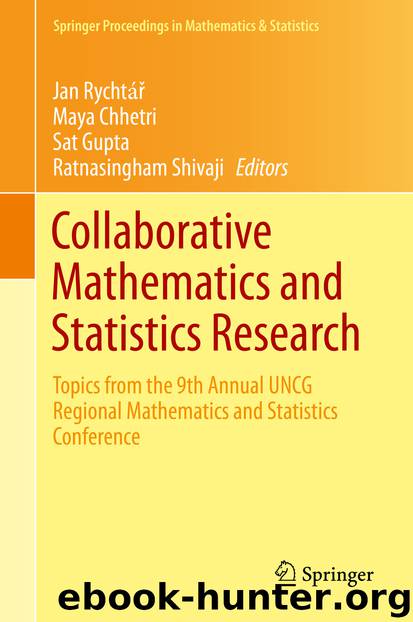Collaborative Mathematics and Statistics Research by Jan Rychtář Maya Chhetri Sat Gupta & Ratnasingham Shivaji

Author:Jan Rychtář, Maya Chhetri, Sat Gupta & Ratnasingham Shivaji
Language: eng
Format: epub
Publisher: Springer International Publishing, Cham
(2)The University of North Carolina at Greensboro, Greensboro, NC 27412, USA
Jasmine Everett
Email: [email protected]
Marwah Jasim
Email: [email protected]
Hyunju Oh (Corresponding author)
Email: [email protected]
Jan Rychtář
Email: [email protected]
Hakimah Smith
Email: [email protected]
1 Introduction
Asian Carp were imported from China in 1970s to improve water quality of aquaculture ponds in the Mississippi river along Illinois. The fish can grow incredibly quickly and can weigh up to 150 pounds and reach an average size of about 30–40 inches. They could eat 5–20 % of their body weight each day, so the species seemed to be an ideal option to control aquatic vegetation. However, having no natural predators, the population of Asian Carp grew exponentially, threatening the native fish whose diet overlaps with the Asian Carp’s diet. The population of native fish now decreases quickly in the upper Mississippi river system [10]. Consequently, Asian Carp are now considered invasive species, highly detrimental to the ecological balance. In April 2012 Congress enacted the “Stop Invasive Species Act” [3]. The act requires the U.S. Corp of Engineers to implement measures to prevent Asian Carp from invading the Great Lakes from the Mississippi through the Chicago area canal system. Also, the Obama Administration released the 2013 Asian Carp Control Strategy Framework [5].
The objective of this paper is to model the interaction between native species and Asian Carp. In Sect. 2 we develop a game-theoretical model evaluating the costs and benefits of the interactions between native predator and prey fish and the invasive Asian Carp species. In Sect. 3 we provide the analysis of the model. More specifically, in Sect. 3.1 we study the conditions under which the native species can coexist (without the presence of Asian Carp). In Sects. 3.2 and 3.3 we study the conditions under which the Asian Carp cannot invade the native fish population. Finally, in Sect. 4 we summarize the findings from previous sections and provide recommendations for potential control measures.
Download
This site does not store any files on its server. We only index and link to content provided by other sites. Please contact the content providers to delete copyright contents if any and email us, we'll remove relevant links or contents immediately.
| Administration & Medicine Economics | Allied Health Professions |
| Basic Sciences | Dentistry |
| History | Medical Informatics |
| Medicine | Nursing |
| Pharmacology | Psychology |
| Research | Veterinary Medicine |
Tuesdays with Morrie by Mitch Albom(4690)
Yoga Anatomy by Kaminoff Leslie(4306)
Science and Development of Muscle Hypertrophy by Brad Schoenfeld(4089)
Bodyweight Strength Training: 12 Weeks to Build Muscle and Burn Fat by Jay Cardiello(3913)
Introduction to Kinesiology by Shirl J. Hoffman(3725)
How Music Works by David Byrne(3187)
Sapiens and Homo Deus by Yuval Noah Harari(2987)
The Plant Paradox by Dr. Steven R. Gundry M.D(2547)
Churchill by Paul Johnson(2506)
Insomniac City by Bill Hayes(2497)
Coroner's Journal by Louis Cataldie(2432)
Hashimoto's Protocol by Izabella Wentz PharmD(2331)
The Chimp Paradox by Peters Dr Steve(2297)
The Universe Inside You by Brian Clegg(2097)
Don't Look Behind You by Lois Duncan(2080)
The Immune System Recovery Plan by Susan Blum(2027)
The Hot Zone by Richard Preston(1983)
Endure by Alex Hutchinson(1964)
Woman: An Intimate Geography by Natalie Angier(1882)
